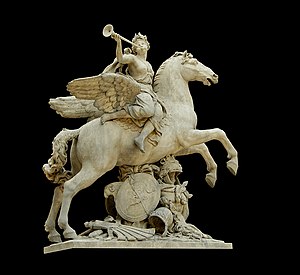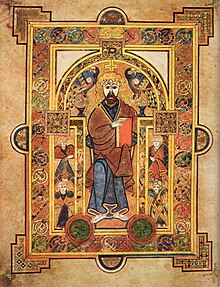Introduction

The visual arts are art forms such as painting, drawing, printmaking, sculpture, ceramics, photography, video, filmmaking, comics, design, crafts, and architecture. Many artistic disciplines, such as performing arts, conceptual art, and textile arts, also involve aspects of the visual arts as well as arts of other types. Also included within the visual arts are the applied arts, such as industrial design, graphic design, fashion design, interior design, and decorative art.
Current usage of the term "visual arts" includes fine art as well as applied or decorative arts and crafts, but this was not always the case. Before the Arts and Crafts Movement in Britain and elsewhere at the turn of the 20th century, the term 'artist' had for some centuries often been restricted to a person working in the fine arts (such as painting, sculpture, or printmaking) and not the decorative arts, crafts, or applied visual arts media. The distinction was emphasized by artists of the Arts and Crafts Movement, who valued vernacular art forms as much as high forms. Art schools made a distinction between the fine arts and the crafts, maintaining that a craftsperson could not be considered a practitioner of the arts. The increasing tendency to privilege painting, and to a lesser degree sculpture, above other arts has been a feature of Western art as well as East Asian art. In both regions, painting has been seen as relying to the highest degree on the imagination of the artist and being the furthest removed from manual labour – in Chinese painting, the most highly valued styles were those of "scholar-painting", at least in theory practiced by gentleman amateurs. The Western hierarchy of genres reflected similar attitudes. (Full article...)
Selected article
The Book of Kells (Latin: Codex Cenannensis; Irish: Leabhar Cheanannais; Dublin, Trinity College Library, MS A. I. [58], sometimes known as the Book of Columba) is an illuminated manuscript and Celtic Gospel book in Latin, containing the four Gospels of the New Testament together with various prefatory texts and tables. It was created in a Columban monastery in either Ireland or Scotland, and may have had contributions from various Columban institutions from each of these areas. It is believed to have been created c. 800 AD. The text of the Gospels is largely drawn from the Vulgate, although it also includes several passages drawn from the earlier versions of the Bible known as the Vetus Latina. It is regarded as a masterwork of Western calligraphy and the pinnacle of Insular illumination. The manuscript takes its name from the Abbey of Kells, County Meath, which was its home for centuries.
The illustrations and ornamentation of the Book of Kells surpass those of other Insular Gospel books in extravagance and complexity. The decoration combines traditional Christian iconography with the ornate swirling motifs typical of Insular art. Figures of humans, animals and mythical beasts, together with Celtic knots and interlacing patterns in vibrant colours, enliven the manuscript's pages. Many of these minor decorative elements are imbued with Christian symbolism and so further emphasise the themes of the major illustrations. (Full article...)Selected picture

Selected quote
| “ | Drawing is the honesty of the art. There is no possibility of cheating. It is either good or bad. | ” |
| — Salvador Dalí, People (September 27, 1976) |
Related portals
Selected biography
Xue Susu (Chinese: 薛素素; also known as Xue Wu(薛五), Xuesu(薛素), Sujun among other pen names) (c.1564–1650? C.E.) was a Chinese Gējì in Ming Dynasty.She was an accomplished painter and poet, and was noted for her skill at mounted archery. She was particularly noted for her figure paintings, which included many Buddhist subjects. Her works are held in a number of museums both in China and elsewhere. Her archery was commented upon by a number of contemporary writers, as were her masculine, martial tendencies; these were regarded as an attractive feature by the literati of the period.
She lived in Eastern China, residing for most of her life in the Zhejiang and Jiangsu districts. After a career as a celebrated Gējì in Nanjing, Xue Susu was married about four times. During her later life, she eventually opted for the life of a Buddhist recluse. (Full article...)Did you know (auto generated) -

- ... that Percy Kelly hoarded his drawings and paintings until the end of his life, saying that his cottage would someday "upstage Beatrix Potter's home"?
- ... that Kip Andersen and Keegan Kuhn were co-nominees for the 2018 Cinema for Peace Award for their documentary What the Health?
- ... that Bernie Wrightson spent seven years drawing an illustrated edition of Mary Shelley's 1818 novel Frankenstein?
- ... that the British rap song "Jiggle Jiggle" by filmmaker Louis Theroux has been used in more than two million TikTok videos?
- ... that a British filmmaker forced the British Board of Film Classification to watch paint drying for ten hours?
- ... that André Delvaux was a magic-realist filmmaker who was made a baron by the king of Belgium?
- ... that Mexican filmmaker David Zonana wrote his first feature film after producing for two other directors?
- ... that The Wiccan Web recommends drawing pentagrams on your computer screen with tinctures?
General images
Major topics
- Types of visual art – Architecture • Art intervention • Ceramic art • Computer art • Drawing • Fashion • Film • Installation art • Land art • Mixed media • Painting • Performance art • Photography • Printmaking • Sculpture • Stained glass
- Art history – Pre-historic art • Ancient art • Art of Ancient Egypt • Art in Ancient Greece • Minoan pottery • Scythian art • Roman art • Women artists
- Western art periods and movements – Medieval art • Gothic art • Renaissance • Mannerism • Baroque • Rococo • Neoclassicism • Romanticism • Realism • Modern Art • Impressionism • Symbolism • Fauvism • Proto-Cubism • Cubism • Futurism • Dada • Art Deco • Surrealism • Abstract Expressionism • Lyrical abstraction • Conceptual Art • Contemporary Art • Postmodern art visual arts.
- Eastern and Middle Eastern art – Buddhist art • Chinese art • Islamic art • Japanese art • Laotian art • Thai art • Tibetan art
- Lists – Architects • Art movements • Art periods • Painters • Printmakers • Sculptors • Statues
- Lists of basic topics – Visual arts • Architecture • Film • Painting • Photography • Sculpture
Subcategories

Architecture | Ceramic art | Comics | Crafts | Design | Drawing | Illustration | Film | Glass | Graphic design | Industrial design | Landscape architecture | Multimedia | Painting | Photography | Pottery | Printmaking | Public art | Sculpture | Typography | Mosaic
Artists | Visual arts awards | Artist collectives | Art collectors | Art critics | Art curators | Visual arts exhibitions | Art forgery | Art history | Visual arts materials | Art schools | Artistic techniques |
WikiProjects
Things you can do
Associated Wikimedia
The following Wikimedia Foundation sister projects provide more on this subject:
-
 Commons
Commons
Free media repository -
 Wikibooks
Wikibooks
Free textbooks and manuals -
 Wikidata
Wikidata
Free knowledge base -
 Wikinews
Wikinews
Free-content news -
 Wikiquote
Wikiquote
Collection of quotations -
 Wikisource
Wikisource
Free-content library -
 Wikiversity
Wikiversity
Free learning tools -
 Wiktionary
Wiktionary
Dictionary and thesaurus








































































Well, that’s interesting to know that Psilotum nudum are known as whisk ferns. Psilotum nudum is the commoner species of the two. While the P. flaccidum is a rare species and is found in the tropical islands. Both the species are usually epiphytic in habit and grow upon tree ferns. These species may also be terrestrial and grow in humus or in the crevices of the rocks.
View the detailed Guide of Psilotum nudum: Detailed Study Of Psilotum Nudum (Whisk Fern), Classification, Anatomy, Reproduction